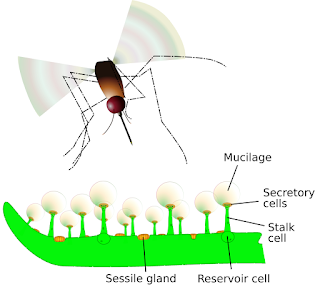Killer Succulents: Carnivorous Butterwort
 |
| Photo via cpukforum.com |
Distribution
 |
| Distribution of butterworts. (Photo via wikimedia.) |
Yes! Butterworts possess carnivorous leaves and succulent leaves. Depending on what kind of butterwort it is, it may cycle in and out of the carnivorous and succulent phase, or it may retain both leaves at the same time. For instance, butterworts from Mexico become non-carnivorous succulents during the subtropical winter dry season.
How are they classified?
Butterworts are classified first by climate: Tropical and Temperate. Then they are subdivided by their leaves: Heterophyllous and Homophyllous. Tropical butterworts do not have a winter dormancy period. Temperate butterworts live where there are cold winter temperatures, so they become resting buds (hibernaculum) during the winter. Heterophyllous means that the carnivorous leaves look different in size and shape from the succulent non-carnivorous leaves. Homophyllous means that the leaves all look identical.Heterophyllous Tropical butterworts have carnivorous leaves during the warm season and succulent, non-carnivorous leaves during the cool season. (P. moranensis, P. gypsicola, P. laxifolia, and P. cyclosecta.) P. cyclosecta is a Mexican butterwort, shown below:
 |
| The Mexican P. cyclosecta in its succulent winter phase (left) and the summer carnivorous phase (right). (Photo via wikimedia.) |
Butterworts eat small insects like midges, fruit flies, ants, gnats, thrips, and mites.
The butterwort uses two specialized glands on its leaf surface to feed: the stalked (peduncular) gland and the sessile gland. The stalked gland has a few components: the reservoir cell holds glycosaminoglycan mucilage, the stalk cell supports a bunch of secretory cells, and the secretory cells secrete the mucilage. The sticky mucilage forms visible droplets on the leaves, attracting insects who are in search of a drink. When the insect lands, becomes stuck, and begins to struggle, more mucilage is secreted, effectively capturing the insect. There are a some digestive enzymes in this mucilage, but its main function is to trap the prey. Some have even evolved thigmotropism and will curl up to trap the insect even more. (Recall that scene in the first Incredibles movie with those black balloons? Yeah, that's what succulents have already figured out.)
 |
| (Photo via wikimedia.) |
Anyway...the sessile glands that lie on the surface of the leaf now secrete some digestive enzymes. Scientists used high resolution cytochemical techniques (specifically, autoradiography) on fresh leaves to discover these enzymes included amylase, esterase, phosphatase, protease, and ribonuclease. How did they do it? The researchers fed the butterwort some radioactive carbon-14 labelled protein. In two hours, they saw that the digestion products had been absorbed into the leaf and in twelve hours, they saw the products move out of the leaf and further into the vascular system. Microautoradiographs were able to track the decay emissions made by the radioactive carbon-14. This study lead to our current understanding of which glands secrete what and what their primary functions are. Finally, the fluids, insect liquid and all, are absorbed into the cuticular holes in the leaf surface. (Read more about the cuticular layer here).
Here are some great places to get these beautiful butterworts.
Curious Plants has some really lovely butterworts (pings)! Sarracenia Northwest also has some pings.
How do I take care of one?
These plants like it hot and humid, so unlike other watering techniques, you do not want to let the soil go bone-dry between waterings. Neither do you want to keep the soil perpetually wet because of root rot. To water butterworts, wet the top soil whenever you see it begin to dry. Keep it out of blazing hot summer sun, a nice window should do the trick, or a suitable growlamp indoors is fine. You can also propagate them by leaf pullings in their succulent form.
For a more in-depth look at the needs of carnivorous plants, check out the Curious Plants Resource Page or the International Carnivorous Plant Society
BONUS:
Thank you to everyone who has been kind enough to let me use their instagram photos!
Weird House Plants (@weirdhouseplants)
Jen (@jenplants2)
Curious Plant (@curiousplant)
Hali'a (@haliapedia)
In case you missed it, here is how I think the butterworts capture their prey. (the balls are the mucilage.)For more Succulent Science fun, hit subscribe!
References
- http://www.cpukforum.com/forum/index.php?/topic/33761-averys-pinguicula-collection-updated-23112010/
- https://worldofsucculents.com/grow-care-butterwort/
- http://www.thecarnivoregirl.com/love-succulents-and-want-to-try-carnivorous-plants-mexican-butterworts-are-easier-than-you-think/
- https://www.gardeningknowhow.com/houseplants/butterwort/how-to-grow-butterworts.htm
- https://www.growcarnivorousplants.com/Articles.asp?ID=263
- http://www.pinguicula.org/pages/plantes/pinguicula_cyclosecta.htm
- Laurent Legendre (2000) The genus Pinguicula L. (Lentibulariaceae): anoverview, Acta Botanica Gallica, 147:1, 77-95, DOI: 10.1080/12538078.2000.10515837
- HESLOP‐HARRISON, Y. O. L. A. N. D. E. "Pinguicula L." Journal of Ecology 92.6 (2004): 1071-1118.




Comments
Post a Comment